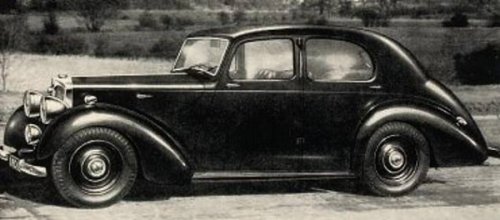Description
The Lea-Francis 12 Saloon, introduced in the mid-1930s, was a refined and well-engineered example of British motoring craftsmanship from one of the country’s most respected smaller manufacturers. It embodied the qualities that defined Lea-Francis cars of the pre-war era—elegance, solid construction, and a focus on both performance and comfort. Positioned as an upper-middle-class touring car, the 12 Saloon was designed to compete with models from Riley, Singer, and MG, offering distinctive character and mechanical sophistication wrapped in graceful coachwork.
Lea-Francis, based in Coventry, had built its reputation through the 1920s and 1930s by producing high-quality, hand-built cars that combined reliability with lively performance. The “12” designation referred to the car’s fiscal horsepower rating, a tax-based measurement used in Britain at the time. Under the bonnet lay a 1.5-litre four-cylinder engine, typically of 1,496 cc capacity, developed in collaboration with the respected engineering firm Meadows. This robust overhead-valve engine was known for its smoothness and flexibility, producing around 45 to 50 horsepower—enough to give the saloon a top speed of approximately 70 mph (112 km/h), impressive for a car in its class.
Power was delivered through a four-speed manual gearbox, operated by a precise, short-throw lever mounted on the floor. The transmission drove the rear wheels via a sturdy live axle, and the suspension system consisted of semi-elliptic leaf springs at both front and rear, giving the car a supple yet stable ride. Braking was handled by mechanically operated drum brakes on all four wheels—typical for the period but carefully engineered for balance and reliability.
Stylistically, the Lea-Francis 12 Saloon was a fine example of understated pre-war British design. The body was traditionally built, with ash framing clad in steel or aluminium panels, giving it both rigidity and a sense of craftsmanship. The lines were graceful rather than flamboyant, with a long bonnet, flowing front wings, and a compact passenger cabin that tapered elegantly toward the rear. A tall, upright grille flanked by chrome headlamps gave the front end a dignified appearance, while subtle coachbuilt details—such as a split windscreen, louvered bonnet sides, and a rear-mounted spare wheel—added to its period charm.
Inside, the 12 Saloon offered a level of comfort and finish that reflected Lea-Francis’s attention to detail. The cabin featured high-quality materials, including leather upholstery, polished wood trim, and a full set of instruments set into a veneered dashboard. Seating for four was comfortable and upright, designed for long-distance touring rather than sporting posture. Excellent visibility, generous headroom, and a quiet-running engine made the car particularly pleasant to drive over long journeys, a hallmark that endeared it to discerning buyers seeking a civilized alternative to more spartan sports cars of the era.
On the road, the Lea-Francis 12 Saloon delivered a well-balanced blend of refinement and performance. The engine was eager and tractable, providing strong mid-range torque ideal for country roads and gentle climbs. The steering was light and accurate, aided by a relatively short wheelbase, which gave the car nimble handling compared to many contemporary saloons. The suspension was tuned for comfort but retained enough firmness to maintain control on rough surfaces, and the mechanical brakes, while requiring a firm pedal, offered progressive and predictable stopping power.
Lea-Francis offered several variants of the 12 model during its production life, including tourer and sports configurations, but the saloon version was the most popular among customers seeking practicality without sacrificing character. Each car was assembled largely by hand, and bodywork was often supplied by specialized coachbuilders, meaning that subtle variations existed between individual examples. This bespoke approach added to the model’s appeal and exclusivity.
Production of the Lea-Francis 12 continued up to the outbreak of the Second World War, when civilian car manufacturing ceased. After the war, the company resumed operations with updated models, but the pre-war 12 Saloon remained a symbol of Lea-Francis’s golden era—a time when the firm’s craftsmanship and engineering excellence placed it among Britain’s finest independent carmakers.
Today, the Lea-Francis 12 Saloon is prized by collectors for its rarity, charm, and quintessentially British character. Surviving examples are admired for their elegant design, mechanical integrity, and the sense of quiet confidence they exude. It captures the spirit of 1930s motoring perfectly: a car built not for ostentation but for those who valued quality, precision, and individuality. In an age when many manufacturers chased mass production, the Lea-Francis 12 Saloon remained true to its maker’s ideals—a beautifully engineered car for the discerning driver.
